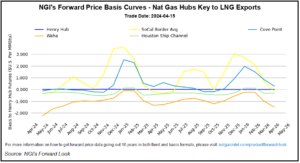Overnight Guidance ‘Materially Cooler’ as Natural Gas Futures Ease Lower Early
A cooler shift in the overnight weather data helped send natural gas futures slightly lower in early trading Wednesday. The August Nymex contract was off 1.3 cents to $1.787/MMBtu at around 8:45 a.m. ET.

The overnight guidance, especially the European model, trended “materially cooler again” by lowering gas-weighted degree day expectations for next week and “showing a less favorable pattern for notable heat” to return in the following week, Bespoke Weather Services said.
“It had appeared the last couple of days that cooler momentum was coming to a halt, but that is not the case,” the forecaster said. “…Cooler weather next week makes sense given the rise in global angular momentum, marking the atmosphere’s move away from the hotter La Nina base state.
“Our view is that this is temporary, and above-normal temperatures can regain the upper hand into the middle third of August, which may still work out, but for now, models are less adamant about this.”
Looking ahead to this week’s Energy Information Administration (EIA) storage report, which covers the week ending July 24, Energy Aspects issued a preliminary estimate for an 18 Bcf injection for the period.
The firm estimated a 3.8 Bcf/d week/week increase in power burn.
“Gas burn bumped against our cap of 48.0 Bcf/d on several days” during the week amid “intense heat” in the Northeast, Energy Aspects said. “The falling injection rate comes despite a sharp increase in Lower 48 production, of 0.8 Bcf/d week/week.” Most of these gains stem from the end of EQT Corp.’s Appalachia deferrals, “which added 0.4 Bcf/d to our regional receipts.” Associated production also “finished the week strong per our flow sample.”
Permian Basin, Bakken Shale and Rockies receipts each were up 0.1 Bcf/d week/week, reversing a decline of a combined 0.3 Bcf/d across the three regions the prior week, according to Energy Aspects.
Other predictions for Thursday’s EIA report have been pointing to an injection in the 20s Bcf range. A Bloomberg survey as of early Wednesday showed a median prediction of 23 Bcf based on six estimates ranging from 18 Bcf to 30 Bcf. NGI’s storage model predicted a build of 24 Bcf.
Last year, EIA recorded a 56 Bcf build for the similar week, and the five-year average is an injection of 33 Bcf.
Meanwhile, a potential tropical cyclone in the Atlantic, dubbed Tropical Cyclone Nine, had a 90% chance of cyclone formation over the next 48 hours, the National Hurricane Center (NHC) said in an 8 a.m. ET advisory.
“The system is moving toward the west-northwest near 23 mph, and this general motion with some reduction in forward speed is expected over the next few days,” the NHC said. “On the forecast track, the system will move near or over Puerto Rico tonight, near or over Hispaniola on Thursday, and near or over the southeastern Bahamas on Friday.”
September crude oil futures were up 29 cents to $41.33/bbl at around 8:45 a.m. ET, while August RBOB gasoline was off fractionally to $1.2643/gal.
© 2024 Natural Gas Intelligence. All rights reserved.
ISSN © 1532-1231 | ISSN © 2577-9877 |


